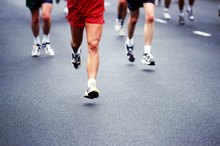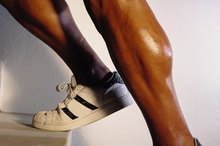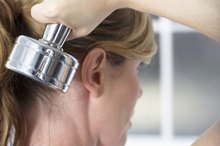How to Get to Single-Digit Body Fat Percentage
Athletes and body builders seek single-digit body fat percentages to improve sports performance and their aesthetic appearance on stage. Getting this lean is possible for men, whose essential fat level is about 5 percent, but not advisable for women, who need about 15 percent to support hormones and menstruation. Focused dieting and workouts are required to reduce body percentage to a low, single-digit level. Low body fat levels create a lean, cut appearance, but men will still be healthy with a body fat of between 10 and 25 percent.
Slow and Steady Weight Loss
Plan to safely lose about 1 percent of body fat per month. Too fast weight loss means you adopt measures that cause you to lose muscle and lower your metabolism, so weight loss becomes harder, and you don't achieve your goal of changing your body composition. If you've already got an athletic body fat level of 10 to 13 percent, aim for just 1/2 to 1 pound of weight loss per week, which requires you to eat 250 to 500 calories fewer than you burn daily. That's equal to just 50 to 100 calories from each meal -- equal to a glass of skim milk, an ounce of cheese or a tablespoon of jam.
You might lose at a faster rate of 1 to 2 pounds per week if you're further from a single-digit body fat goal. This rate requires a 500- to 1,000-calorie deficit created by combining a decrease in food consumption and an increase in physical activity, especially in the weight room.
How to Eat to Decrease Body Fat
How to Lose Fat & Gain Lean Body Mass
Learn More
You can't eat fast and junk food and expect to achieve a single-digit body fat. Diligent portioning of whole, unprocessed foods and an adequate intake of protein is required. Aim for four or five mini meals containing one to two palm-sized portions of lean protein, one to two fist-sized portions of watery, fibrous vegetables and about 2 teaspoons of healthy, unsaturated fats. This spreads your calorie intake out so you're consistently providing your body with nutrients -- specifically protein -- and don't get so hungry at any point that you binge. Plan to have 1/2 to 1 cup of unrefined carbohydrates, such as brown rice, quinoa, bananas or starchy vegetables, at meals following workouts.
Sample meals include grilled chicken breast with broccoli topped with toasted almonds; broiled flank steak with a leafy green salad dressed with olive oil; or salmon with roast asparagus. After a workout, have a scoop of whey protein blended with a banana, milk and berries or 1 cup of quinoa mixed with water-packed tuna, celery, mustard and avocado.
When you're on a mission to lose body fat by weight training and cutting calories -- like when you're preparing for a bodybuilding contest -- a daily intake of protein between 1 and 1.4 grams per pound of body weight is recommended, according to a review published by the International Society of Sports Nutrition in 2014. If that seems like a lot of protein, it is. For a 180-pound man, that's between 180 and 252 grams of protein daily. Spread this protein out over the course of your four to five mini meals. A scoop of whey protein usually contains between 20 and 25 grams of protein; a cup of cooked chicken, 40 grams; and 6 ounces of broiled flank steak, about 46 grams.
Note though, that this amount of protein is more than most men need to eat on a regular basis, even those who lift weights several days a week. If you've had any kidney problems, check with your doctor about what's an appropriate protein intake for you.
A Gym Commitment to Lose Body Fat
To reduce body fat significantly, plan on an almost daily visit to the gym for 60 minutes or longer. Some days, you may even need to do a morning and evening session to fit in all the exercises you need to reach single-digit body fat. Do four or five of these weekly sessions at an intensity that causes you to break a sweat. High-intensity intervals involving bouts of burpees, battling ropes and sprints are examples of the types of workouts that can help encourage fat loss. Two or three weekly sessions of light cardio, such as 20 minutes of incline walking or moderate cycling on an indoor trainer, support heart health and burn extra calories without being so excessive to cause the loss of muscle.
Weight training promotes muscle retention and growth as you reduce calories to lose body fat. Aim for multiple exercises for each major muscle group for three to six sets of eight to 12 repetitions. Rest just 30 to 60 seconds between sets. Because of this large volume of weight training, it's helpful to follow a split-workout schedule where you work different muscle groups throughout the week. For example, on Monday, do exercises for legs and shoulders; Tuesday, work biceps and back; Wednesday, work the chest, triceps and abdominals; and take Thursday off. Then, Friday, start the sequence over again. A split workout regimen ensures you give each muscle group at least 48 hours of rest between sessions for each muscle group and get an entire day of rest from strength training once per week.
Lifestyle Changes For a Single-Digit Body Fat Percentage
What Are the Best Ways to Decrease Your Body Fat Percentage?
Learn More
Your strict diet means restaurant visits should occur very rarely -- just once or twice per week at the most. You can't control the ingredients and additives in these meals. You'll also want to avoid alcohol and other caloric drinks as well as sweets and desserts. An occasional splurge once or twice per month is OK, but limit them as much as possible. Your gym regimen means you might need to wake up extra early, skip social functions and even limit vacation travel to places with access to workout facilities.
Attaining a lean body also requires quality sleep of eight to nine hours per night. Sleep is the time the body repairs and releases growth hormone to help muscle development. Destressing regularly also keeps your hormones, specifically the stress hormone cortisol, in check. Too much cortisol encourages your body to store fat. Yoga, meditation or just down-time reading and relaxing actually helps your body-fat loss.
Related Articles
References
- University of New Mexico: Getting a Grip on Body Composition
- Precision Nutrition: The Cost of Getting Lean
- Journal of the International Society of Sports Nutrition: Evidence-Based Recommendations For Natural Bodybuilding Contest Preparation: Nutrition and Supplementation
- Healthaliciousness: Nutrition Facts Comparison Tool: Skim Milk, Cheddar Cheese, Jam
- American Council on Exercise: What are the Guidelines for Percentage of Body Fat Lost?
- Healthaliciousness: Nutrition Facts Comparison Tool: Protein Powder, Chicken, Flank Steak
- Bodybuilding.com: How Much Protein?
Writer Bio
Andrea Cespedes is a professionally trained chef who has focused studies in nutrition. With more than 20 years of experience in the fitness industry, she coaches cycling and running and teaches Pilates and yoga. She is an American Council on Exercise-certified personal trainer, RYT-200 and has degrees from Princeton and Columbia University.









